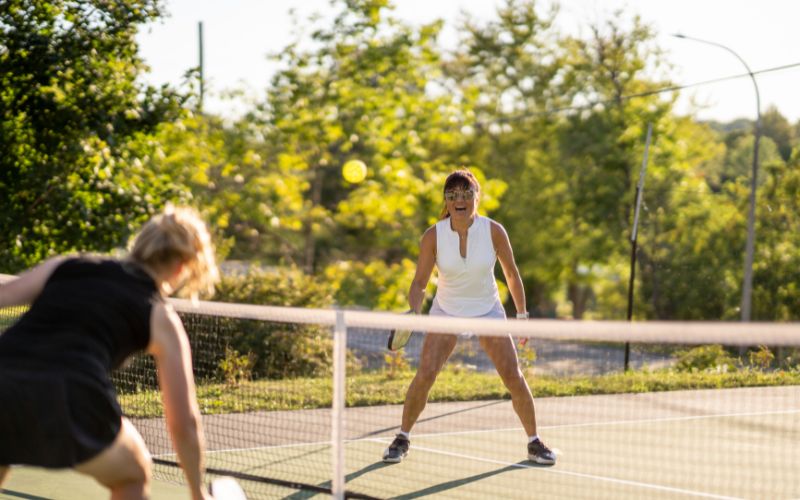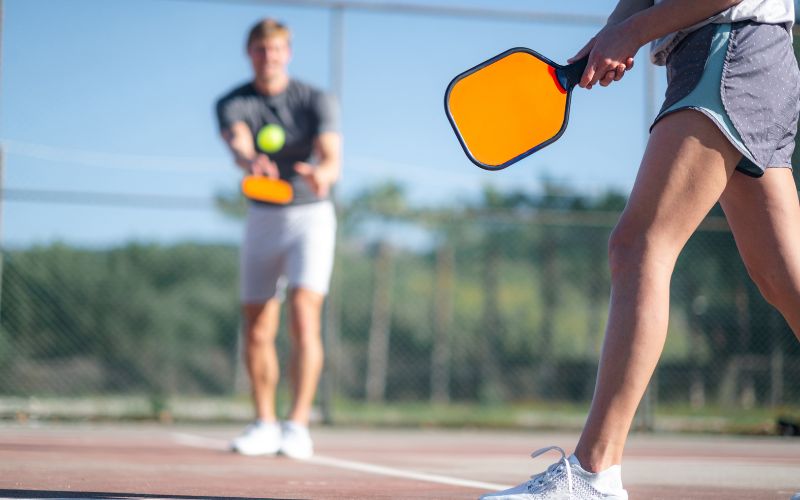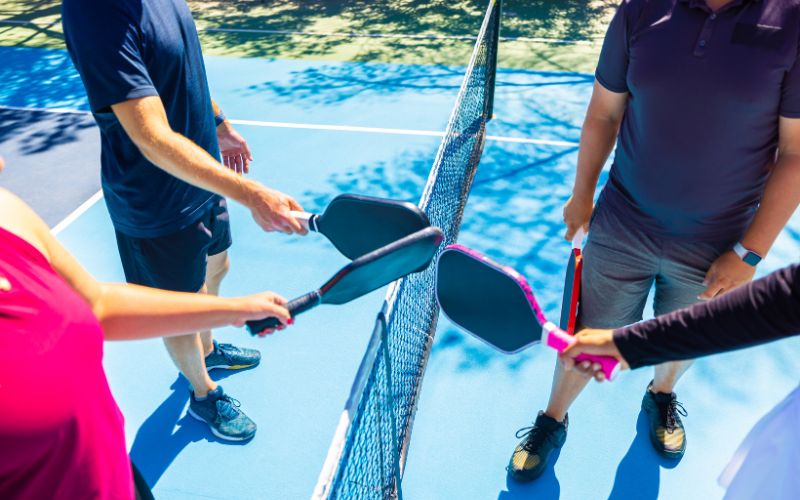Pickleball, the fastest growing sport in the United States, has captured the attention of players of all ages and skill levels. Why is pickleball so popular and why has it seen such a surge in popularity in recent years? In this article, we delve into the various factors contributing to the widespread appeal of pickleball.
How to Play Pickleball?
In the game of pickleball, a net spanning three feet in height is positioned at the center of a court that measures 44 feet in length and 20 feet in width. Players have the option to engage in singles or doubles matches, where teams alternate hitting the ball across the net. Points are awarded to the serving side if the receiving team fails to return the volley successfully. The game typically progresses until one team reaches 11 points, though a winning margin of two points is necessary for victory.
Pickleball involves certain nuances typical of court-based sports, such as determining the serving order and the designated side for serving the ball. Additionally, a distinct feature known as the “kitchen,” a no-volley zone, is situated seven feet away from the net on both ends of the court.
Various regulations govern aspects like score calling, tournament protocols, and distinctions between singles and doubles matches for pickleball enthusiasts, affectionately referred to as “picklers.” Fortunately, newcomers to the sport can grasp the fundamentals after just a few matches, rendering pickleball easily accessible to all.
The Rise of Pickleball
Pickleball, a sport that combines elements of tennis, badminton, and ping pong, originated in Bainbridge Island, Washington, in the mid-1960s. Since then, it has evolved into a beloved recreational activity and competitive sport played worldwide. So, why has pickleball become such a phenomenon?
1. Accessibility and Ease of Play
One of the primary reasons behind pickleball’s popularity is its accessibility. Unlike traditional tennis courts that require ample space, pickleball courts are smaller and can often be found in community centers and recreation departments. The smaller court size makes it more manageable for players of all ages and abilities, including those with physical limitations.
2. Social Engagement and Community Building
Pickleball is not just a sport; it’s a social activity that fosters connections and camaraderie among players. Whether you’re a seasoned athlete or a newcomer to the game, pickleball offers opportunities to meet new friends and engage in mixed doubles matches. The social aspect of pickleball is particularly appealing to older adults and younger players alike, providing a sense of belonging and inclusion within the community.
3. Health and Fitness Benefits
Beyond its social aspects, pickleball offers numerous health benefits. It provides a good cardiovascular workout while improving hand-eye coordination and reflexes. Additionally, pickleball can be an excellent mental health booster, offering stress relief and a sense of accomplishment with each game played. The fitness industry association recognizes pickleball as a valuable form of exercise that promotes overall well-being.
Reduces Instances of Depression
According to a study, individuals engaged in pickleball tend to exhibit lower levels of depression. The research tracked 153 older adults participating in pickleball competitions. Conclusively, it was observed that a commitment to meaningful leisure pursuits, such as the systematic engagement in hobbies, correlates with decreased depression rates.
Enhances Cardiovascular Fitness
While pickleball may not match the intensity of tennis, it provides substantial cardiovascular benefits. Research indicates that individuals engaging in hour-long pickleball sessions three times a week experience enhancements in cardiorespiratory fitness, reduced cholesterol levels, and lowered blood pressure. Experts suggest that pickleball presents a viable alternative to conventional exercise modalities like walking or cycling for adults seeking to increase physical activity.
Improves Hand-Eye Coordination
Pickleball doesn’t demand lightning-fast footwork, but it does require adept hand-eye coordination and strategic reflexes. Coordinating movements across feet, legs, arms, hands, and eyes can enhance reflexes, stimulate rapid cognitive processing, and improve balance. In older adults, engaging in physical activities that involve cognitive challenges has been associated with improved cognitive health and a reduction in the risk of cognitive decline.
4. Adaptability and Versatility
Another factor contributing to pickleball’s popularity is its adaptability. Whether played casually or competitively, pickleball can accommodate players of varying skill levels. The rules are simple to learn, yet the game offers depth and strategy that can challenge even the most experienced athletes. Pickleball can also be played indoors or outdoors, making it suitable for year-round enjoyment.
5. Rise of Professional Pickleball
The emergence of professional pickleball associations and tournaments has further fueled interest in the sport. Major League Pickleball events such as the USA Pickleball Association and USA Pickleball National Championships showcase the skill and athleticism of top pickleball players, inspiring enthusiasts to improve their pickleball games and compete at higher levels. The recognition of pickleball as a legitimate racquet sport by major organizations has elevated its status in the world of sports.
6. Cultural Phenomenon
Pickleball has become more than just a game; it’s a cultural phenomenon. From smaller courts popping up in neighborhoods to the availability of pickleball equipment in big box stores, the sport has infiltrated mainstream culture. Its fast-paced nature and dynamic gameplay appeal to a wide audience, including bored kids looking for a new activity and adults seeking a fun way to stay active.
Who Can Participate in Pickleball?
A more appropriate query might be, who wouldn’t relish the opportunity to engage in pickleball? This activity caters to a diverse audience, especially seniors attracted to its gentle impact on joints. Despite its leisurely pace, pickleball offers substantial health benefits and serves as a delightful platform for socializing. These characteristics also render it an ideal leisure pursuit for families.
The health perks of pickleball transcend age boundaries. Families can savor the bonding experience of a casual match, with parents and grandparents not needing to fret over the younger members’ proficiency levels. Pickleball is relatively straightforward to grasp and provides an immediate mood lift, requiring minimal practice.
Even competitive athletes can derive pleasure from participating in pickleball matches. Furthermore, the sport’s low-impact nature facilitates sweating it out during cross-training sessions—a fantastic alternative for those seeking respite from more vigorous sports like basketball. Seasoned athletes, still imbued with a competitive spirit but finding traditional high-energy sports taxing, often embrace pickleball. However, one needn’t be an athlete or fall into a specific age bracket to engage in or reap the benefits of pickleball.
Conclusion
In conclusion, the popularity of pickleball can be attributed to its accessibility, social engagement, health benefits, adaptability, and cultural significance. As more people discover the joy of playing pickleball, the sport continues to grow and evolve, leaving a lasting impact on the athletic and recreational landscape. Whether you’re a seasoned pro or a newcomer to the game, pickleball offers something for everyone to enjoy. So grab a paddle, hit the court, and experience the thrill of pickleball for yourself!
FAQs About Pickleball
1. How do you play pickleball?
Pickleball involves setting up a three-foot net at the center of a court measuring 44 feet by 20 feet. Players can engage in singles or doubles matches, volleying the ball over the net. The game typically progresses until one team reaches 11 points, with a two-point margin required for victory. There are nuances regarding serving order, court dimensions, and gameplay rules that players need to familiarize themselves with.
2. What are the primary reasons behind the popularity of pickleball?
Pickleball’s popularity stems from its accessibility and ease of play. Unlike traditional tennis courts, pickleball courts are smaller and can be found in community centers and recreation departments. Its inclusive nature makes it appealing to players of all ages and skill levels, fostering social engagement and community building.
3. What health benefits does pickleball offer?
Pickleball provides cardiovascular exercise, improves hand-eye coordination, and enhances reflexes. Engaging in regular pickleball sessions has been linked to reduced levels of depression, improved cardiovascular fitness, and cognitive health. It offers a fun and effective way to stay active while enjoying the camaraderie of fellow players.
4. Who can participate in pickleball?
Pickleball is suitable for individuals of all ages and fitness levels. It caters to seniors seeking joint-friendly activities, families looking for recreational bonding experiences, and competitive athletes seeking a low-impact alternative to traditional sports. The sport’s adaptability and versatility make it accessible to everyone, regardless of athletic background.
5. What makes pickleball a cultural phenomenon?
Pickleball’s rise from a niche activity to a cultural phenomenon can be attributed to its dynamic gameplay, inclusivity, and accessibility. The sport has infiltrated mainstream culture, with courts popping up in neighborhoods and equipment readily available in stores. Its fast-paced nature appeals to a wide audience, making it a popular choice for both casual players and competitive athletes alike.






